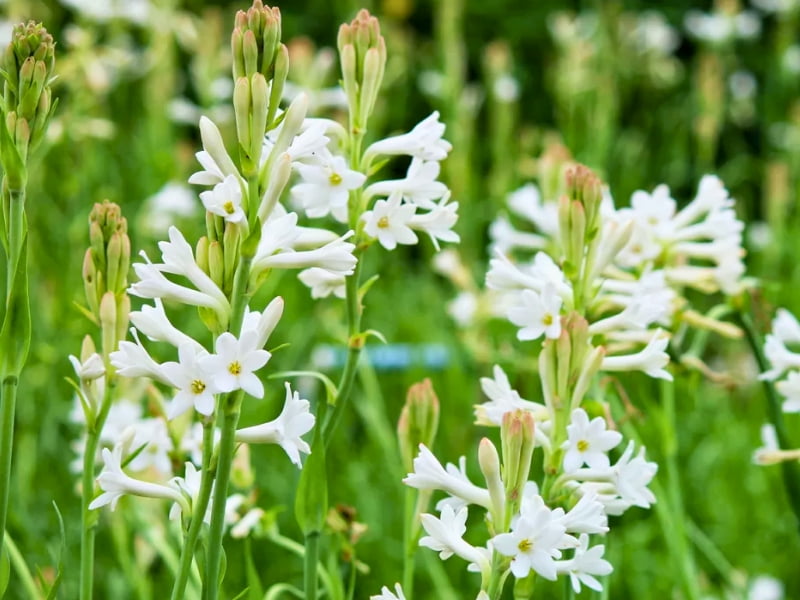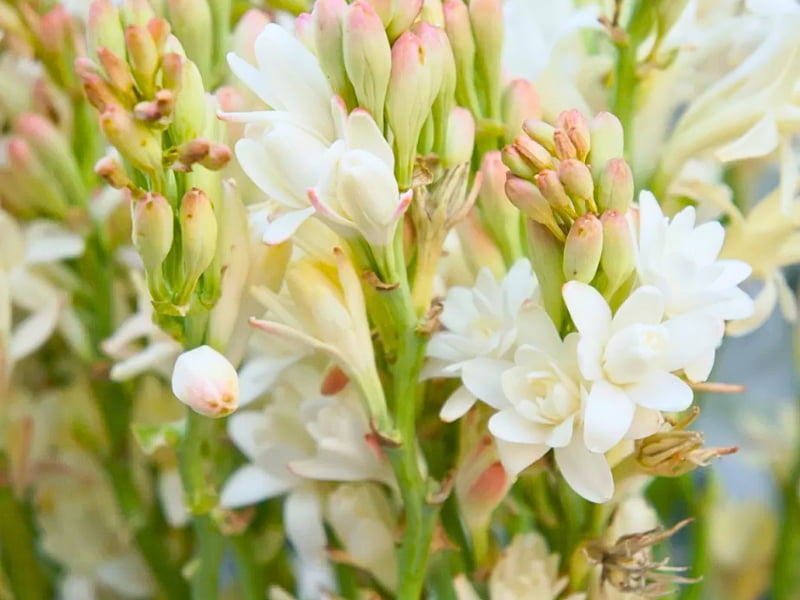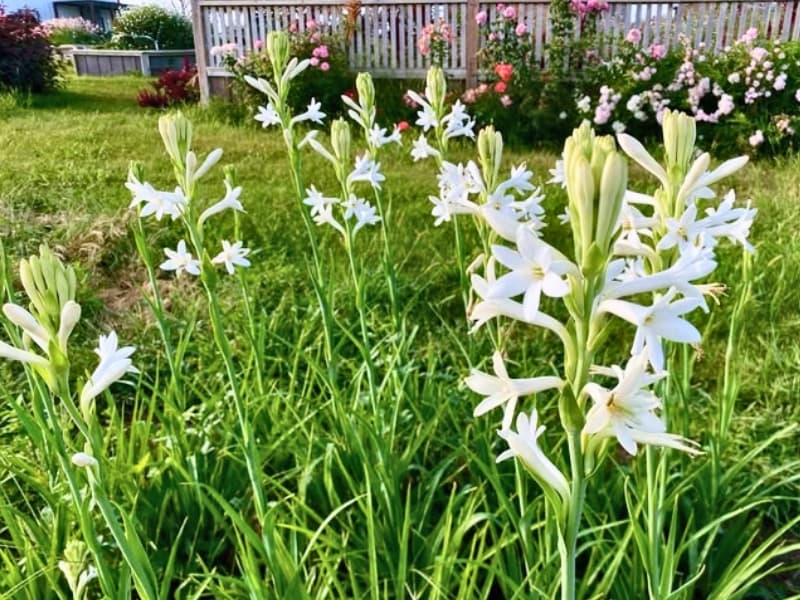Tuberose, also commonly known as Polianthes tuberosa, or sometimes called “The Mistress of the Night,” is a captivating, fragrant flower with a rich history and diverse uses. Its botanical name, Polianthes tuberosa, hints at its elegant, white blossoms and tuberous root system. From tuberose perfume and essential oils to stunning cut flower arrangements, this plant offers a wide array of possibilities.
This article will delve into the fascinating world of the Tuberose, covering its origins, growth habits, care requirements, and various applications. Get ready to discover the secrets to cultivating this exquisite bloom and harnessing its alluring fragrance. Continue reading to explore the benefits of adding this tuberose flower to your garden or finding the perfect tuberose bulbs for your needs.

Tuberose: A Deep Dive into the Fragrant Queen of the Night
Tuberose, a native to Mexico, holds a special place in the world of floriculture and perfumery. Its intoxicating fragrance, released primarily in the evening, has earned it nicknames like “Night Queen” and “Mistress of the Night.” But beyond its captivating scent, the tuberose offers a compelling story of cultural significance, diverse uses, and specific cultivation needs.
Historical Roots and Cultural Significance
The history of tuberose is as rich as its perfume. Aztecs cultivated this plant centuries ago, valuing it for both its ornamental beauty and medicinal properties. They used it in religious ceremonies and traditional remedies. From Mexico, the tuberose journeyed across the globe, finding favor in various cultures.
In Victorian England, the tuberose symbolized “dangerous pleasure” and “voluptuousness” in the language of flowers, adding a layer of intrigue to its already captivating allure. In India, it’s a staple in wedding garlands and religious offerings, representing purity and auspiciousness. This global journey showcases the flower’s adaptability and enduring appeal. The tuberose also has a significant role to perfumery since the 17th Century, when the flower was transported to Europe.
Botanical Classification and Characteristics
- Botanical Name: Polianthes tuberosa
- Family: Asparagaceae (formerly Agavaceae)
- Common Names: Tuberose, Night Queen, Mistress of the Night
- Plant Type: Perennial (in warmer climates), often grown as an annual
- Native Region: Mexico
- Growth Habit: Clump-forming, with tall, slender stems
- Height: 2-4 feet (60-120 cm)
- Flower Color: Predominantly white, with some cultivars exhibiting pink or yellowish hues.
- Bloom Time: Late summer to early fall
- Fragrance: Intensely sweet, heavy, and complex, with notes of jasmine, gardenia, and honey.
- Hardiness Zones: USDA Zones 7-10 (can be grown as annuals in colder zones)
Understanding the Tuberose Plant Structure
The tuberose plant consists of several key components:
- Bulbs (Technically Tubers): These are the underground storage organs, resembling small, elongated potatoes. They store nutrients and energy, allowing the plant to survive dormant periods.
- Leaves: Long, slender, grass-like leaves emerge from the base of the plant.
- Flower Stems: Tall, sturdy stems (scapes) rise from the center of the leaf cluster.
- Flowers: Waxy, tubular flowers are arranged in clusters (racemes) along the upper portion of the stem. Each flower has six petals (technically tepals) that flare outwards.
Distinguishing Features
Tuberose is often confused with other fragrant white flowers, but several features set it apart:
- Intense Night Fragrance: The fragrance is significantly stronger in the evening and at night.
- Waxy Flower Texture: The petals have a distinctive, almost waxy feel.
- Tubular Flower Shape: The flowers are long and tubular, unlike the more open shape of lilies or gardenias.
- Late Bloomer: The flower typically begins to bloom in the late summer, and lasts through fall.
Varieties and Cultivars While the classic tuberose is known for its pristine white flowers, several cultivars offer variations in color and form:
| Cultivar | Description | Flower Color |
| ‘The Pearl’ | Double-flowered variety with numerous, tightly packed petals, creating a fuller, more rounded flower shape. The most popular variety for cut flowers. | Pure White |
| ‘Single Mexican’ | The original, single-flowered type. Known for its exceptionally strong fragrance. | Pure White |
| ‘Pink Sapphire’ | A rare cultivar with soft pink flowers. | Soft Pink |
| ‘Yellow Baby’ | Features pale yellow flowers. | Pale Yellow |
| ‘Cinderella’ | Another rare variety, which features light pink flowers. | Light Pink |
Growing Tuberose: A Comprehensive Guide to Planting and Care
Choosing the Right Bulbs (Tubers)
The success of growing tuberose starts with selecting healthy, high-quality bulbs (technically tubers). Here’s what to look for:
- Size: Larger bulbs generally produce more flowers. Look for bulbs that are at least 1 inch (2.5 cm) in diameter.
- Firmness: The bulbs should be firm to the touch, not soft or mushy.
- Appearance: Avoid bulbs with signs of mold, rot, or damage.
- Source: Purchase bulbs from reputable suppliers, such as specialized nurseries or online retailers known for quality plant material. This addresses the “where to buy tuberose bulbs” search intent. Gardencenterpoint.com can guide you to reliable sources for purchasing tuberose bulbs.
Planting Time and Location
- Timing: Plant tuberose bulbs in the spring after the last frost has passed and the soil has warmed up to at least 60°F (15°C).
- Location: Choose a sunny location that receives at least 6-8 hours of direct sunlight per day. Tuberoses thrive in full sun.
- Soil: Well-drained soil is crucial. Amend heavy clay soils with compost or other organic matter to improve drainage. The ideal soil pH is between 6.0 and 7.5.
Planting Instructions: Step-by-Step
- Prepare the Soil: Loosen the soil to a depth of 12 inches (30 cm). Incorporate compost or other organic matter to improve drainage and fertility.
- Dig Holes: Dig holes 4-6 inches (10-15 cm) deep and 6-8 inches (15-20 cm) apart.
- Plant the Bulbs: Place the bulbs in the holes with the pointed end facing up.
- Cover with Soil: Fill the holes with soil, gently firming it around the bulbs.
- Water Thoroughly: Water the newly planted bulbs deeply.
Watering and Fertilizing
- Watering: Keep the soil consistently moist, but not waterlogged. Water deeply when the top inch of soil feels dry.
- Fertilizing: Tuberoses are heavy feeders. Apply a balanced fertilizer (e.g., 10-10-10) every 4-6 weeks during the growing season. Alternatively, use a slow-release fertilizer at planting time.
Ongoing Care
- Staking: Taller varieties may require staking to prevent the flower stems from bending or breaking.
- Mulching: Apply a layer of mulch (e.g., shredded bark, straw) around the plants to conserve moisture, suppress weeds, and regulate soil temperature.
- Deadheading: Remove spent flowers to encourage continued blooming. Cut the flower stalks back to the base after all the flowers have faded.
- Weeding: Regularly remove any weeds.
Overwintering (in Colder Climates)
In USDA Zones colder than 7, tuberose bulbs will not survive the winter outdoors. You have two options:
- Treat as Annuals: Simply replant new bulbs each spring.
- Dig and Store: In the fall, after the foliage has died back, carefully dig up the bulbs. Allow them to dry for a few days in a well-ventilated area. Remove any remaining foliage and store the bulbs in a cool, dry, dark place (e.g., a basement or garage) at around 50-60°F (10-15°C) until the following spring.
Pest and Disease Management
Tuberoses are generally pest and disease-resistant, but it’s important to be aware of potential problems:
- Aphids: These small insects can suck sap from the leaves and stems. Control them with insecticidal soap or neem oil.
- Spider Mites: These tiny pests thrive in hot, dry conditions. They can cause yellowing and stippling of the leaves. Control them with a strong spray of water or miticide.
- Bulb Rot: This fungal disease can occur in poorly drained soils. Prevent it by ensuring good drainage and avoiding overwatering.

Tuberose Perfume and Essential Oil: Extraction, Uses, and Benefits
The Allure of Tuberose Fragrance
The defining characteristic of tuberose is its intoxicating fragrance. It’s a complex, heady scent often described as:
- Sweet: Possessing a rich, honey-like sweetness.
- Floral: Exhibiting strong notes of jasmine, gardenia, and other white flowers.
- Creamy: Having a smooth, velvety texture to the fragrance.
- Intense: The scent is potent and long-lasting.
- Nocturnal: The fragrance is most pronounced in the evening and at night.
This unique fragrance profile makes tuberose a highly prized ingredient in perfumery.
Extraction Methods
Extracting the delicate fragrance of tuberose requires specialized techniques. Two primary methods are used:
- Enfleurage: This traditional method is labor-intensive and rarely used commercially today. Freshly picked tuberose flowers are placed on trays coated with a layer of odorless fat (usually a combination of animal fats). The fat absorbs the fragrance from the flowers over several days. The process is repeated with fresh flowers until the fat is saturated with the scent. The resulting fragrant fat is called a “pomade.” The pomade is then washed with alcohol to extract the essential oil, resulting in an “absolute.”
- Solvent Extraction: This is the most common method used today. Fresh tuberose flowers are immersed in a solvent (e.g., hexane). The solvent dissolves the fragrant compounds from the flowers. The solvent is then evaporated, leaving behind a waxy substance called a “concrete.” The concrete is further processed with alcohol to remove the waxes and pigments, resulting in an “absolute.”
Tuberose Absolute vs. Essential Oil
Technically, the fragrant extract from tuberose is called an “absolute,” not an “essential oil.” This is because it’s obtained through solvent extraction, not steam distillation (which is used to produce true essential oils). However, the term “tuberose essential oil” is often used colloquially.
Uses of Tuberose Perfume and Absolute
- Perfumery: Tuberose absolute is a highly valued ingredient in high-end perfumes. It adds a rich, sensual, and long-lasting floral note. It’s often used in oriental, floral, and chypre fragrances.
- Aromatherapy: While not as common as some other floral absolutes, tuberose absolute can be used in aromatherapy for its purported relaxing and mood-enhancing properties. However, it should be used sparingly due to its intensity. It should always be diluted in a carrier oil before applying to the skin.
- Cosmetics: Tuberose absolute can be found in some high-end skincare products for its fragrance and purported skin-conditioning properties.
- Candles and Soaps: Due to the strength, Tuberoses are also a favorite to use in fragranced candles and soaps.
Buying Tuberose Essential Oil (Absolute)
When purchasing tuberose absolute, it’s crucial to buy from reputable suppliers. Pure tuberose absolute is expensive due to the labor-intensive extraction process. Be wary of products that seem too cheap, as they may be diluted or adulterated. Gardencenterpoint.com can help you locate trustworthy vendors of tuberose essential oil and related products.
Safety Precautions
- Dilution: Tuberose absolute is highly concentrated and should always be diluted in a carrier oil (e.g., jojoba oil, almond oil) before applying to the skin.
- Pregnancy: Pregnant and breastfeeding women should consult with a healthcare professional before using tuberose absolute.
- Allergies: Perform a patch test before using tuberose absolute to check for any allergic reactions.
Tuberose Flower: Arrangements, Symbolism, and Meaning
Tuberose in Floral Arrangements
Tuberose flowers are prized for their elegant appearance and long vase life, making them a popular choice for:
- Wedding Bouquets: Their classic white color and intoxicating fragrance make them a favorite for bridal bouquets and wedding decorations.
- Cut Flower Arrangements: Tuberose adds a touch of sophistication and luxury to any floral arrangement. They pair well with other fragrant flowers like roses, lilies, and gardenias.
- Corsages and Boutonnieres: Single tuberose blossoms can be used to create elegant corsages and boutonnieres.
- Event Decorations: Tuberoses are often used to decorate special events, such as weddings, anniversaries, and parties.
Tips for Using Tuberose in Arrangements
- Vase Life: Tuberoses have a relatively long vase life, typically lasting 7-10 days.
- Water: Change the water in the vase every 1-2 days and recut the stems at an angle.
- Flower Food: Use flower food to prolong the life of the flowers.
- Placement: Avoid placing the arrangement in direct sunlight or near heat sources, as this can shorten the vase life.
- Fragrance: Be mindful of the strong fragrance, especially in enclosed spaces.
Symbolism and Meaning of Tuberose
The tuberose has accumulated various symbolic meanings across different cultures:
- Victorian Era: In the language of flowers, tuberose symbolized “dangerous pleasure” and “voluptuousness.”
- India: In India, tuberose is associated with purity, innocence, and auspiciousness. It’s often used in wedding garlands and religious offerings.
- Mexico: In its native Mexico, tuberose has a long history of use in traditional ceremonies and remedies.
- General Symbolism: Tuberose can also represent sensuality, passion, and love.
Tuberose Colors and Their Meanings
While white is the most common color for tuberoses, there are a few cultivars with different color variations:
- White Tuberose: Represents purity, innocence, and elegance.
- Pink Tuberose: Symbolizes affection, romance, and grace.
- Yellow Tuberose: Represents joy, happiness, and friendship.

Tuberose Colors: Beyond White
The Classic White
The most common color, by far, is white. The vast majority of cultivars, and those used most frequently in the floral and perfume industries are white. This pure white color is often associated with the symbolic meaning of the flower, including purity.
Pink Tuberose
As noted above, there are some Tuberose cultivars that bloom in a pink hue. These are significantly less common, and often more difficult to find. The shades range from a light pink to a bolder, almost rose-like color.
Yellow Tuberose
Yellow cultivars of Tuberose are another variation of the flower. As with the pink variety, they are not as common as the traditional white bloom.
Other Colors
While the vast majority are white, pink or yellow, breeders are continuously working to develop new colors and variations. This remains an area for potential new discoveries.
Tuberose Meaning: A Deeper Look at Symbolism
Historical and Cultural Significance
- Ancient Aztecs: Used tuberose in religious ceremonies and traditional medicine.
- Victorian England: Symbolized “dangerous pleasure” and “voluptuousness.”
- India: Represents purity and auspiciousness; used in weddings and religious offerings.
- Modern Symbolism: Often associated with sensuality, passion, and deep emotion.
Spiritual and Emotional Associations
- Aromatherapy: The scent is believed to have calming and mood-enhancing properties.
- Emotional Connection: Often used to express deep affection and love.
Variations in Meaning by Color As described in the previous section, each color variation of Tuberose can carry a distinct meaning. This further elaborates on the meaning, from a number of perspectives.

Leave a Reply